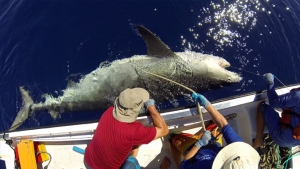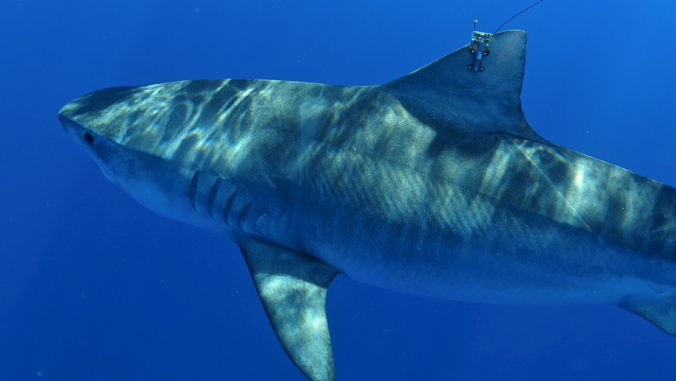Researchers have been tagging sharks for decades to learn about their habits and migration patterns. In recent years, University of Hawaiʻi at Mānoa researchers have tapped tiger sharks to help capture other data critical to measuring changes in the ocean and weather, all while they continue to swim out their normal lives.
Research Professor Kim Holland at the Hawaiʻi Institute of Marine Biology has been studying sharks for 30 years. Holland and his team have been attaching tags to tiger sharks off of Oʻahu and Maui to collect data that will help feed into oceanographic and meteorological models.
“Sharks play an extremely important role in the world’s ecosystems,” Holland said. “So it’s really important for us to know what habitats they choose, how far they go, what their behavior is.”


UH researchers travel by boat and lay out lines with bait and hooks. When a tiger shark takes the bait, researchers pull the shark close to secure it front and back to the boat and flip it over, putting the tiger shark into a temporary state of inactivity called tonic immobility. During this time, researchers measure the tiger shark, and when it’s flipped back over, they have a few minutes to attach a tag to its dorsal fin before it wakes up and swims away.
The tags work as very small, sophisticated computers measuring ocean depth, temperature, salinity, dissolved oxygen and light levels. When a tagged tiger shark comes to the water’s surface, the tag’s antenna will transmit the data collected via satellite and land-based stations.
“So we’re trying to increase the amount of science that we can get out of these tracking projects, by employing this new generation of tags,” said Holland. “Which tells us not only where the shark is going and how deep it is, but also is telling us about its environment.”
The Pacific Islands Ocean Observing System based at UH Mānoa, and the Integrated Ocean Observing System are supporting this project and are in the process of making the oceanographic data available through the Animal Telemetry Network.
“We can provide data on a much denser more frequent basis than traditional oceanography can,” said Holland. “This will improve our understanding of how the ocean is rapidly changing and this in turn can improve weather forecasting.”
UH researchers choose to work with tiger sharks because they can study their behavior and impact on human safety, as tiger sharks are the species most involved in attacks on humans. Tiger sharks have a significant role in the environment as a top-level predator and are easier for researchers to work with because of their susceptibility to tonic immobility. However, Holland hopes the research will expand to other species including blue sharks and hammerhead sharks, which travel to other parts of the ocean and have different diving patterns.
—By Sarah Hendrix


